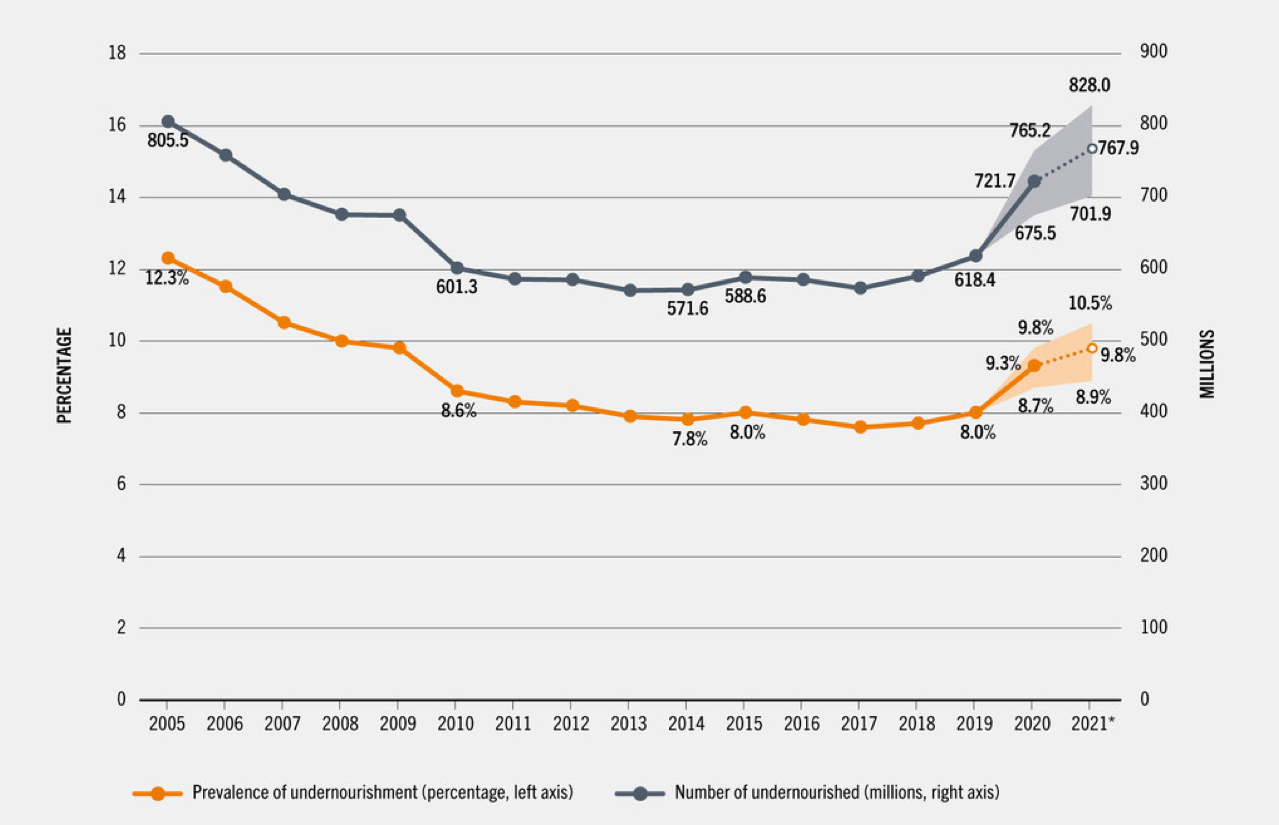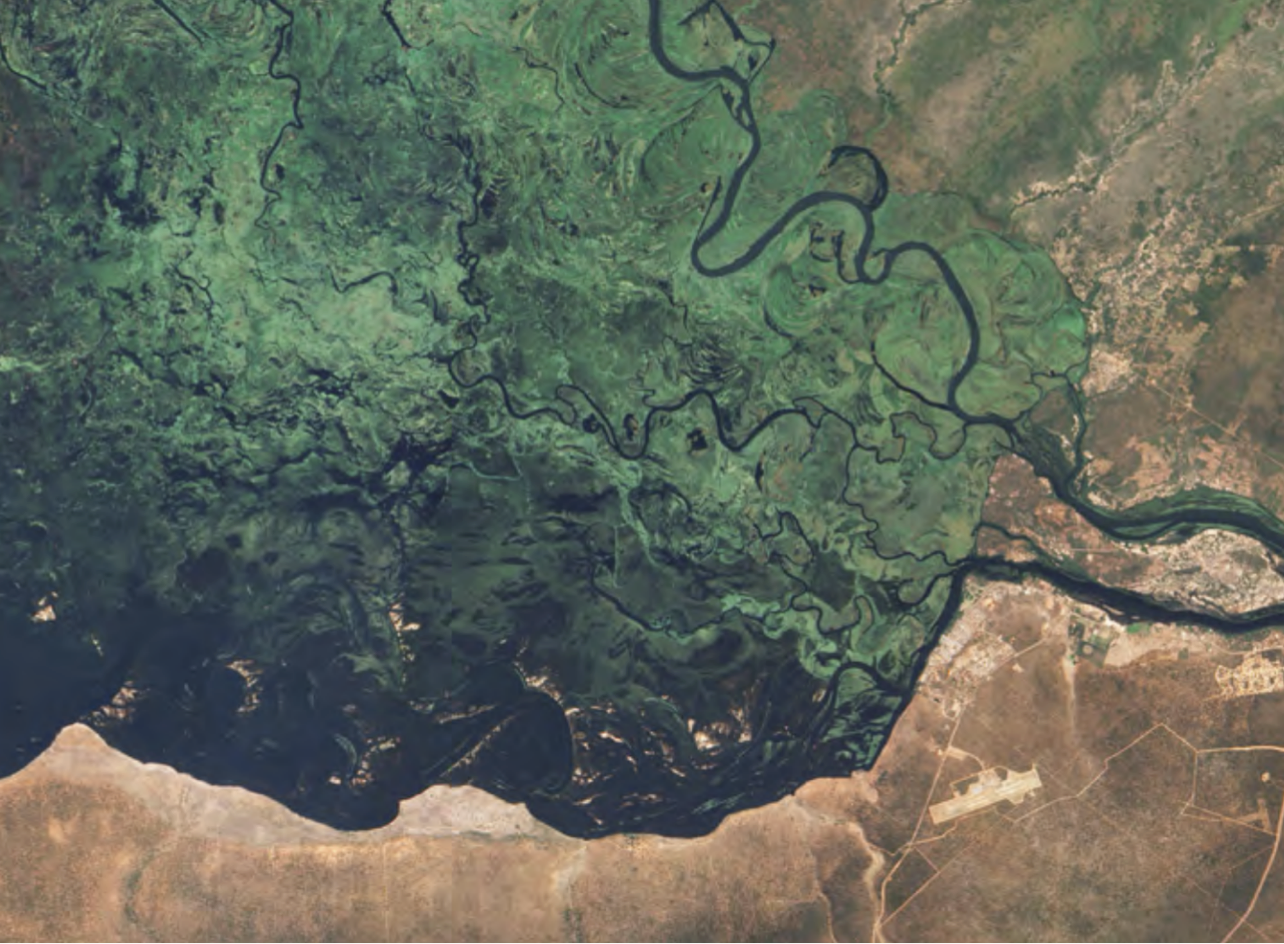Leveraging Space Technology to Cure World Hunger
GRC 2023 Global Essay Competition Top 10
By Junjie Yan and Zhouhan Wu
As weeks pass by, the outline of her bones that once used to be hidden under her plump arms became increasingly visible. With food shortages in Niger worsening, 14-month-old Fatchima had no other choice but to survive on water from the village well.
She is not the only one. The world is back at hunger levels not seen since 2005. By 2022, around 735 million people (9.2% of the world population) suffered from chronic hunger, and an estimated 2.4 billion people experienced moderate to severe food insecurity. Annually, world hunger leads to the death of 6 million children under the age of 5. Solving world hunger is not just a key UN Sustainable Development Goal - it has the potential to improve education and equality, unlocking prosperity for our society.
Yet, the answer to this global food pandemic may lie somewhere far from home. Through integrating AI, automation, and tele-communication capabilities in space technology, food production can be augmented to solve the problem of world hunger.

Figure 1: Percentage/Number of Undernourished Worldwide
Unpacking World Hunger
According to McKinsey Global Institute, the world’s population will reach 9.7 billion by 2050, requiring a corresponding 70 percent increase in food available for consumption. However, resource constraint means that food production needs to be more efficient and less susceptible to risks such as climate change and conflicts. Across the world, farmers are facing difficulties adapting their agrarian cycles to the ever more erratic and fluctuating weather patterns as a result of climate change. Hurricane Matthew, which scientists claim was worsened by global warming, annihilated an astonishing 75% of farmer’s stock and two-thirds of farm animals in Haiti.
However, simply focusing on one side of the equation is not enough. In fact, enough food is produced to meet the needs of the world population annually, underscoring the issue of food distribution. Therefore, measures such as improving the humanitarian supply chain through space technology should not be ignored.
Maximising Crop Yield
Precision agriculture enabled by space satellite technology can help maximise crop yield. In 2021, the Landsat 9 satellite was launched in the western United States to collect open-source data on evapotranspiration rates - the process of water loss through plant leaves, soils, and other surfaces. This helps farmers estimate the amount of water used by their fields and the amount that needs to be replaced through irrigation. Real-time monitoring and big data analysis help improve water management, a paramount issue in developing regions such as Sub-Saharan Africa where water shortage is common and most inhabitants survive on subsistence agriculture. Integrating space technology in developing nations’ agricultural ecosystems is thus an effective strategy to improve productivity and reduce hunger rates.
The impacts of natural disasters could be minimised if governments and farmers are given sufficient time to react. This is especially paramount for many developing economies as they do not have advanced irrigation systems to protect against more unpredictable drought patterns. Global navigation satellite system (GNSS) services make use of high-resolution imagery and detailed elevation models to forecast future climate patterns; for instance, the floods of the Zambezi and Chobe Rivers in Namibia. Machine learning, integrated with these forecasts and a database of trialled local agricultural practices, can develop timely and actionable countermeasures for farmers. For example, sugarcane farmers in Kenya experience, on average, an 11.5% increase in productivity after receiving personalised SMS messages on farming practices. Additionally, climate forecasts can provide a buffer period for humanitarian agencies to deliver food aid. Satellites such as Elon Musk’s Starlink can help improve connectivity in rural areas, strengthening global food distribution networks.

Image 1: GNSS Imaging of the Zambezi and Chobe Rivers in Namibia During a Flood
Genetic Endeavours
Plant breeding in outer space could open a myriad of new agricultural opportunities. The abundant cosmic radiation in outer space could induce new genetic mutations in plants that can exponentially increase plant yield and beget new favourable traits in the process known as space mutagenesis. Luyuan 502, the second most grown wheat in China, was created 340km above Earth in an automated retrievable satellite. It has displayed new traits including more tolerance to droughts and increased resistance to some diseases. The species is also 11% more productive compared to normal wheat. Space mutagenesis can be a silver bullet for scientists to create a resilient crop - one that resists extreme climate conditions, produces higher yield with less water consumption, and has an elevated nutrient content, meeting the demands of a growing world population.
Conclusion
Space technology strengthens connectivity in rural agricultural communities, improves data collection about weather patterns and crop yields, and can even lead to genetic crop improvements. These deliver promising prospects for the future of global food production. However, it is important to note that economic factors such as continued investment in R&D and aid for developing countries are just as important in transforming this vision into reality.
References
- Abeeb Babatunde Omotoso et al., “Climate Change and Variability in Sub-Saharan Africa: A Systematic Review of Trends and Impacts on Agriculture,” Journal of Cleaner Production 414 (August 1, 2023): 137487, https://doi.org/10.1016/j.jclepro.2023.137487.
- Brookings. “Addressing Africa’s Extreme Water Insecurity | Brookings,” March 9, 2022. https://www.brookings.edu/articles/addressing-africas-extreme-water-insecurity.
- Food Security Portal. “ICTs to Improve Food Security and Aid Agricultural Initiatives | Food Security Portal,” n.d. https://www.foodsecurityportal.org/blog/icts-improve-food-security-and-aid-agricultu ral-initiatives.
- Goedde, Lutz, Joshua Katz, Alexandre Menard, and Julien Revellat. “Agriculture’s Connected Future: How Technology Can Yield New Growth.” McKinsey & Company, October 9, 2020. https://www.mckinsey.com/industries/agriculture/our-insights/agricultures-connected- future-how-technology-can-yield-new-growth.
- Martin. “Goal 2: Zero Hunger - United Nations Sustainable Development.” United Nations Sustainable Development, October 19, 2023. https://www.un.org/sustainabledevelopment/hunger/.
- NASA. “OpenET: A Satellite-Based Water Data Resource - NASA,” n.d. https://www.nasa.gov/image-article/openet-satellite-based-water-data-resource/.
- Nordin, Remar. “Starlink to Come to Rural Areas within a Year, Says Teo.” The Star, September 2, 2023. https://www.thestar.com.my/news/nation/2023/09/02/starlink-to-come-to-rural-areas- within-a-year-says-teo.
- Pittman, Craig. “Scientists: Climate Change Made Hurricane Matthew Stronger.” Tampa Bay Times, August 24, 2019. https://www.tampabay.com/news/weather/hurricanes/scientists-climate-change-made- hurricane-matthew-stronger/2296996/#:~:text=You%20can't%20blame%20climate,th e%20heat%20of%20warm%20water.
- “Inadequate Food Distribution Systems | Mission 2014: Feeding the World,” n.d. http://12.000.scripts.mit.edu/mission2014/problems/inadequate-food-distribution-syst ems.
- “The State of Food Insecurity in the World 2002,” n.d. https://www.fao.org/3/Y7352e/y7352e03.htm.
- Save the Children. “Fatchima’s Story,” n.d. https://www.savethechildren.org/us/charity-stories/fatchima.
- Saunders, Mia. “Satellite Technology to Help Boost Food Security in East Africa.” University of Leeds, November 20, 2023. https://www.leeds.ac.uk/main-index/news/article/5459/satellite-technology-to-help-bo ost-food-security-in-east-africa#:~:text=By%20leveraging%20advanced%20satellit% 20technology,food%20security%20in%20the%20region.%E2%80%9D.
- “Six Months after Hurricane Matthew, a Food and Nutritional Crisis Is Beginning in Haiti: We Must React - Haiti,” ReliefWeb, April 5, 2017, https://reliefweb.int/report/haiti/six-months-after-hurricane-matthew-food-and-nutritio nal-crisis-beginning-haiti-we-must.
- Tereza Pultarova, “How China Is Creating New Foods in Space,” BBC Future, July 11, 2022,
- https://www.bbc.com/future/article/20220708-how-china-is-creating-new-foods-in-sp ace.
- The Economist. “Outer Space Offers Plant Breeders Some Curious Advantages.” The Economist, January 6, 2022. https://www.economist.com/science-and-technology/outer-space-offers-plant-breeders -some-curious-advantages/21807014.
- UN News. “World Is Moving Backwards on Eliminating Hunger and Malnutrition, UN Report Reveals,” July 11, 2022. https://news.un.org/en/story/2022/07/1122032.
- United Nations Office for Outer Space Affairs. “Use of Space Technology within the United Nations System” n.d. https://www.unoosa.org/res/oosadoc/data/documents/2016/stspace/stspace69_0_html/ st_space_69E.pdf.
- World Food Program USA. “6 Causes of World Hunger - Why There Is Global Food Insecurity,” March 20, 2023. https://www.wfpusa.org/drivers-of-hunger/.



